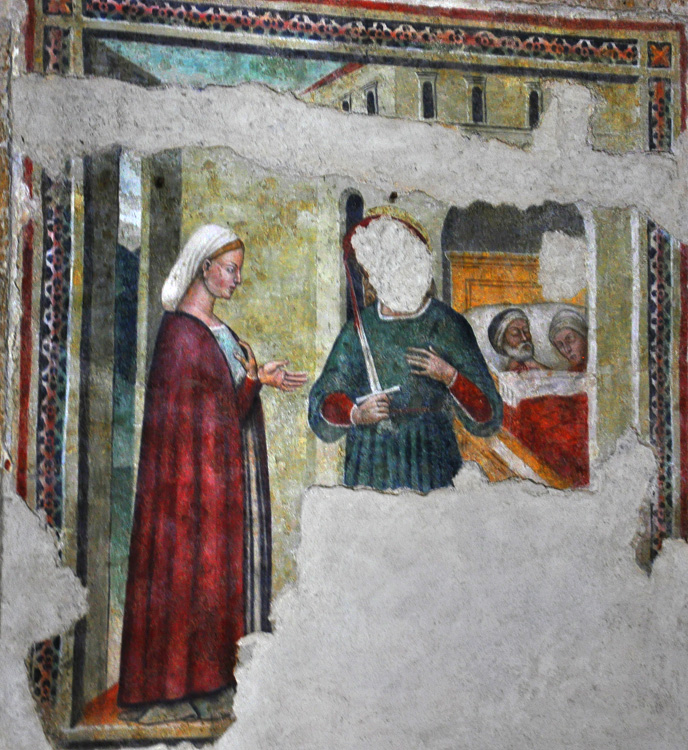In penance, Julian and his wife leave home and establish a hospice for travelers and the poor. One day they are visited by a leper who is shivering from the cold. St. Julian takes him in and even warms him in his own bed. The leper turns out to be an angel with a message that the Lord has accepted his repentance. Of the couple's death Golden Legend says only that they "rendered unto God their souls," but in the version printed in the Acta Sanctorum they are murdered by robbers.
In portraits, St. Julian the Hospitaller's attribute is a wrapped sword, as in the first and third images at right. The legends have him "noble and young" when his story begins, and that is how he is usually portrayed. According to the Acta Sanctorum, his images in Sicily have him dressed as a hunter. In his portrait in Mantegna's St. Luke Altarpiece he holds a palm branch, a result of a confusion between him and the martyr St. Julian of Auvergne.
Comparisons to the Oedipus story are obvious, but the differences point to a more intense level of emotional unity in the family. After St. Julian disappears from home, his parents leave their own lives behind in order to search for him, a search that ends in his unwittingly killing them as they sleep together in the dark. Furthermore, St. Julian's wife is innocent of the crime yet she insists on sharing his penance because "like as I have had joy of you, so will I have pain and heaviness."
In the Dominican Museum in Dubrovnik, Croatia, an altarpiece by Nikola Božidarovič includes a portrait of St. Julian (his name in his halo) with a sheathed sword held downward in the left hand and a falcon or hawk on the right hand. A French life of the saint mentions a hawk among the gifts given to young Julian.
Prepared in 2014 by Richard Stracke, Emeritus Professor of English, Augusta University
HOME PAGE

Portrait by Taddeo Gaddi, 1340s (See the description page)

Julian after killing his parents (See the description page)

In a 15th-century altarpiece (See the description page)
ATTRIBUTES
- Wrapped sword
- Falcon or hawk
MORE IMAGES
- 1390s: A portrait of St. Julian with his wrapped sword is included in the right wing of Cenni di Francesco's Coronation of the Virgin Altarpiece.
- 1541: Detail from Carpaccio's St. Vitalis on Horseback and Eight Saints
BIOGRAPHY
- Golden Legend #30: html or pdf
- The Life of St. Julian the Hospitaller (translation of a French life).
- Acta Sanctorum, January vol. 2, 977.